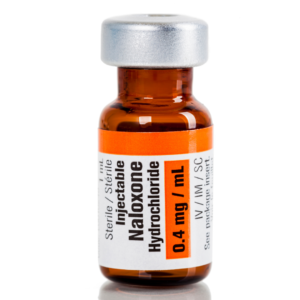In the United States, opioids are the leading cause of drug-related deaths – out of the nearly 71,000 people who died from a drug overdose in 2019, 70% of those deaths were opioid-related, many involving synthetic opioids. The opioid crisis is not unique to the U.S., with over 70% of drug-related deaths worldwide related to opioids.
Total overdose deaths compared to opioid-related overdose deaths
70% of drug-related deaths worldwide are related to opioids. @who
What are opioids, and what causes people to overdose when using them?
An opioid is any substance that binds to opioid receptors in the central nervous system. Naturally occurring opioids, also called opiates, are derived from the opium poppy flower. More commonly known examples of opioids include morphine and codeine.
Semisynthetic opioids, like heroin, are made from opiates. Synthetic opioids, including fentanyl, have a similar structure as naturally occurring opioids, except they are made in a lab and are considerably stronger, and cheaper and faster to produce.
What happens in your body during an opioid overdose?
Opioids are depressants, meaning they inhibit the central nervous system (CNS). During an overdose, opioids depress the CNS, leading to decreased breathing, blood pressure, and heart rate.
In extreme cases, your body can actually forget how to breathe.
Signs and symptoms of an overdose include pinpoint pupils, unconsciousness, and difficulties breathing.
In extreme cases of an opioid-related overdose, your body can actually forget how to breathe.
What are the consequences of an overdose?
The most severe overdoses lead to death. Although most overdoses don’t lead to death, they can still have serious consequences.
Studies have shown that prolonged substance use and non-fatal overdoses that don’t lead to death can cause toxic brain damage. There are two main types of toxic brain injuries resulting from the brain not receiving enough oxygen: hypoxic and anoxic.
Hypoxic brain injuries occur when oxygen to the brain is restricted, while anoxic brain injuries happen there is a lack of oxygen to the brain.
For both, the severity of the injury is dependent on how long the brain went without enough oxygen.
Reversing an opioid overdose
When it comes to treating a person who has overdosed on opioids, timing is everything. The longer a person remains in an overdosed state, the greater their chance of dying – and every minute can increase the amount of damage done to the brain.

One way experts are preventing opioid-related overdose deaths is by increasing the availability of naloxone, a non-addictive medication designed to reverse the effects of an opioid overdose. If administered on time, it can be lifesaving.
When it comes to treating a person who has overdosed on opioids, timing is everything.
What are the risk factors associated with opioid overdose?
An opioid overdose can happen to anyone who takes opioids, but there are a few factors that increase your risk:
1. Resuming opioids after an extended period without usage
When a person uses opioids for an extended period of time, they may build up a tolerance. As their body becomes accustomed to the medication, they need a larger or more frequent dosage to experience the same degree of effect.
When a person stops taking opioids after long-term usage, they may experience a loss of tolerance. For example, loss of tolerance can happen if a person goes through a detox program or enters treatment for substance abuse. When a person who loses tolerance retakes the opioid, they can overdose if they try taking the same amount they took previously.
2. Injecting opioids as opposed to ingesting them orally
Another way people misuse opioids is by taking them in ways other than how their doctor prescribed them. One method that increases the risk of overdose is injection.
When someone injects opioids, the drug reaches the brain faster and with a more substantial effect.
OxyContin is an opioid that is meant to be released slowly into the body so that it lasts for a longer period of time. People misuse OxyContin by snorting or injecting it, causing them to receive more of the medication than intended and increasing the risk of overdose.
3. Using opioids with alcohol or certain medications
Taking opioids with alcohol or other medicines that suppress respiratory function can also increase overdose risk. Barbiturates, anesthetics and certain pain medications are a few examples of medications that do not mix well with opioids.
For example, Benzodiazepine also referred to as benzos, is a prescription sedative. In 2019, 16% of opioid-related overdose deaths involved benzos. Opioids and benzos are a dangerous combination because they both sedate users and affect breathing, which causes overdose death.
Other factors that increase the risk of an opioid overdose include:
- Having an opioid-use disorder
- Using prescription opioids without medical supervision
- Being prescribed a high dosage of opioids
- Having concurrent medical conditions
Final thoughts on opioid overdose
An opioid overdose can happen to anyone. By understanding the risks associated with opioids and knowing the signs and how to handle an overdose, we can take steps to prevent opioid-related overdose deaths.
An opioid overdose can happen to anyone.


A Solution to the Opioid Crisis
ZICOH will utilize a secure database integrated with AI to form a unique software architecture and advanced patented technology, making it the first device of its kind to enable effective communication through the drug supply chain, from drug manufacturers to wholesalers, distributors, pharmacists, providers, physicians, caregivers, and patients. The device can be programmed to dispense the medication dosage amount, type, and frequency to patients according to the health care provider’s orders and delivery schedule. Each of its features helps ensure patient compliance and patient follow-up, consequentially reducing the risk of addiction and overdose.


